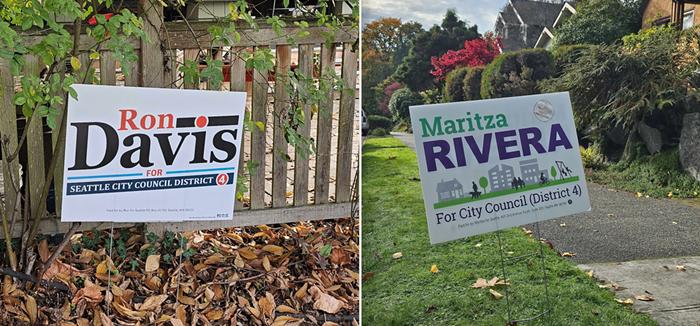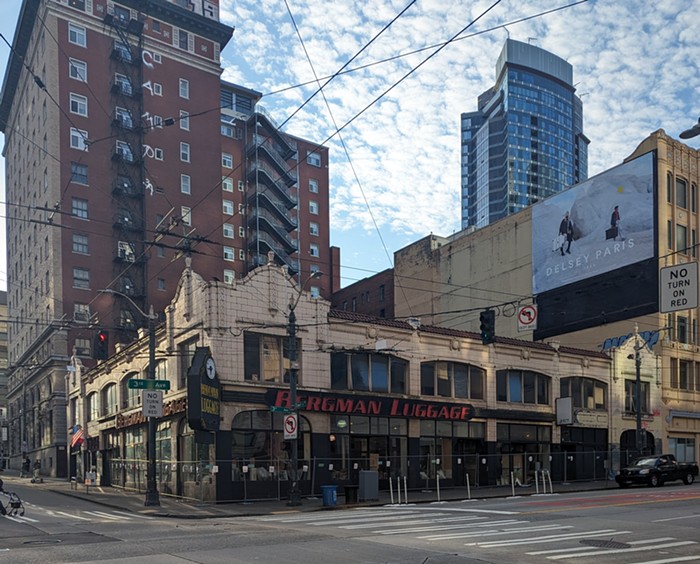King County Elections certified the results of the 2023 election on Tuesday, making official the conservative slate’s looming takeover of the Seattle City Council. But given the state of their pocketbooks, conservatives may celebrate their victories with prosecco instead of champagne, as big business spent a fuck-ton to, in some cases, win by a few hundred votes in a low-turnout election.
Combining campaign spending and Independent Expenditures (IE) for a given candidate, on average conservatives spent $22.44 per vote, and their progressive opponents spent $13.75 per vote, according to the most recent data from the PDC and the Seattle Ethics and Elections Committee.
In the 2019 Seattle City Council election, IEs backed by business and labor spent more competitively, but this year labor didn’t play ball. It's unclear why labor IEs spent close to $900,000 on the city council races in 2019 and less than $200,000 this year, but some speculate that unions had less money after supporting Lorena González’s 2021 mayoral campaign, or that the unions wanted to spend more money on actual worker organizing instead of largely disappointing politicians. I mean, labor paid $500,000 to get Council Member Andrew Lewis elected just so he could gut labor policy on a whim. Yikes.
Conservatives did not win a clean sweep, though. Lefty Council Member Tammy Morales and lesser-of-two-evils Council Member Dan Strauss both won reelection. Taking their victories into account, winning candidates spent about $20.15 per vote. And in all but one race, the winners spent more.
Big Money, Small Victory
In the clearest example of big money barely beating a more grassroots campaign, City insider and allegedly bad boss Maritza Rivera won by a mere 235 votes despite hundreds of thousands of dollars flooding in from landlords, big business, and wealthy Republicans. Rivera’s campaign and an IE supporting her spent a combined $403,000, or $28.37 per vote, to narrowly surpass Urbanist Father™ Ron Davis, who only spent $13.35 per vote.
Davis did a fine job fundraising through his campaign, drawing more donations than Rivera, but he failed to inspire large outside spending. A labor IE spent about $16,000 on his campaign, which means Rivera enjoyed 14 times more outside spending than the candidate she just barely beat.
Similarly, in District 7, challenger Bob Kettle beat incumbent Andrew Lewis by just 439 votes. Between his campaign and the IE that supported him, Kettle’s seat cost $33.20 per vote, making him the most expensive candidate per vote in any of the seven races.
Talk About Budget Inefficiencies
But in some cases, business probably didn’t have to spend quite so much. For example, Cathy Moore, who found support from both big business and labor, won the District 5 race in a landslide, collecting 64% of the vote. Her campaign and the IE supporting her spent $318,000 to get her elected even though her opponent, ChrisTiana ObeySumner, saw no outside spending.
In the case of Moore and ObeySumner, business and labor probably could have taken a more hands-off approach, like they did in District 6, where they collabed on the cheapest victory of the election. With outside spenders icing out his challenger, Strauss won his re-election at just $12.35 per vote.
I’m Sensing a Pattern
The highest bidder won in Districts 1 and 3 as well.
Big tech lawyer Rob Saka beat tech worker and environmentalist Maren Costa by nearly 3,000 votes, the second-strongest lead in the City. Saka’s campaign spent $195,000, and he got a $217,000 boost from outside spending, pricing his victory at about $22.41 per vote.
Meanwhile, Costa spent $180,000 and garnered an additional $106,000 from labor IEs, making her the biggest expense to labor out of any of the seven races. Each vote for Costa cost $18.56.
Cannabis-grower Joy Hollingsworth’s District 3 seat cost about $17.72 per vote. Her campaign spent $162,000 and a mix of business and labor IEs spent $152,000 on her. Her competitor, urbanist nonprofit type Alex Hudson, spent $143,000 herself, and an IE threw in $62,000 to support her election. That means Hudson ran at more than a $100,000 deficit compared to Hollingsworth, spending about $13.12 per vote. She lost by a little more than 2,000 votes.
🎉 Morales 🎉
Seattle’s only triumph over big business interests came in District 2. Morales’s reelection cost her campaign, in combination with a small effort from a labor IE, $11.44 per vote. It cost $28.86 per vote for her challenger, Tanya Woo, to lose by 403 votes. As the third-highest cost per vote in the council races, and business’ only real loss, Woo’s campaign shaped up to be the biggest waste of money this cycle. But with all her friends on the council, she may have a shot at the appointment to the vacancy that Council Member Teresa Mosqueda will leave behind at the end of the year.
NEW: Hearing that there's a "serious movement" to get failed City Council candidate Tanya Woo appointed to Mosqueda's position. For context: https://t.co/956ImLjjVz
— Hannah Krieg (@hannahkrieg) November 15, 2023
Aside from Morales’s race, this year—like most years—money reigned supreme.




















